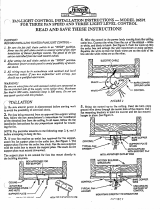
www.HunterFan.com
1.888.830.1326
M0069-01 • 02/09/16 • © Hunter Fan Company
What to Expect with Your Installation
Know your wiring
If you are unfamiliar
with wiring, use a
qualied electrician.
You may need a
friend to help you.
Check box to see
fan weight
Assess location
30 inches
from blade tip
to nearest wall
or obstruction
7 feet
from bottom
edge of blade
to the oor
Select a downrod length
Assess ceiling angle
Must be able to
secure the fan to
building structure or
fan-rated outlet box
1
2
3
Standard Downrod
for ceilings 8-10 feet high
Shorter Downrod
for fans installed close to ceiling
Longer Downrod
for ceilings 10 feet or higher
2
Ceiling angles greater
than 34° will require an
Angled Mounting Kit.
See page 4 for details.
Read and Save These Instructions
This product conforms to UL Standard 507.
WARNINGS
CAUTIONS
w.1 - To reduce the risk of re, electrical shock, or personal
injury, mount fan directly from building structure and/or an
outlet box marked acceptable for fan support of 70 lbs (31.8 kg)
and use the mounting screws provided with the outlet box.
w.2 - To avoid possible electrical shock, before installing or
servicing your fan, disconnect the power by turning off the
circuit breakers to the outlet box and associated wall switch
location. If you cannot lock the circuit breakers in the off
position, securely fasten a prominent warning device, such as a
tag, to the service panel.
w.3 - To reduce the risk of re, electrical shock, or motor damage,
use only Hunter Speed Controls.
w.4 - To reduce the risk of personal injury, do not bend the blade
brackets when installing the blade brackets, balancing the blades,
or cleaning the fan. Do not insert foreign objects in between
rotating fan blades.
c.1 - All wiring must be in accordance with national and local
electrical codes ANSI/NFPA 70. If you are unfamiliar with wiring,
use a qualied electrician.
c.2 - Use only Hunter replacement parts.
This equipment has been tested and found to comply with the
limits for a Class B digital device, pursuant to part 15 of the FCC
Rules. These limits are to provide reasonable protection against
harmful interference in a residential installation. This equipment
generates, uses and can radiate radio frequency energy and if not
installed and used in accordance with the instructions may cause
harmful interference to radio communications.




























